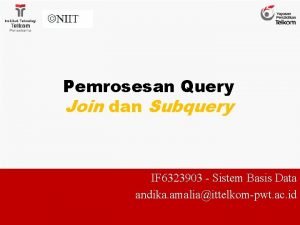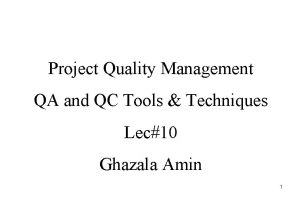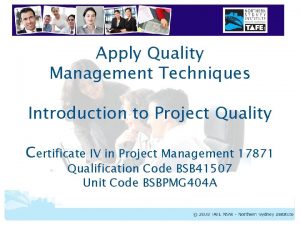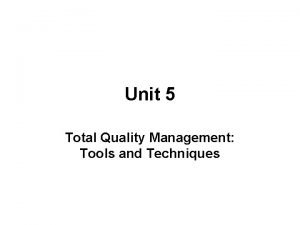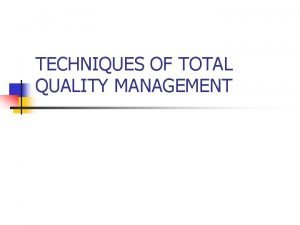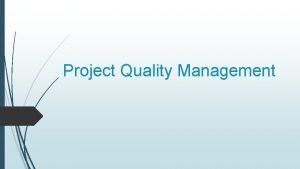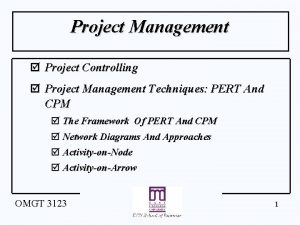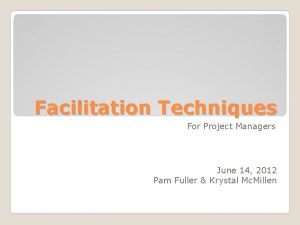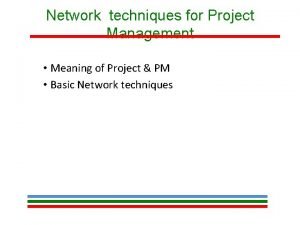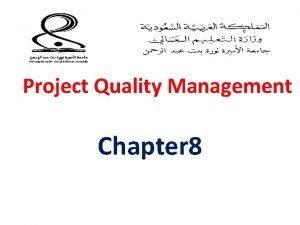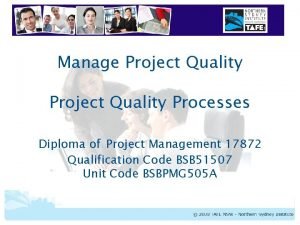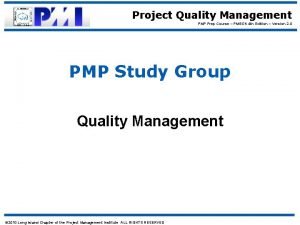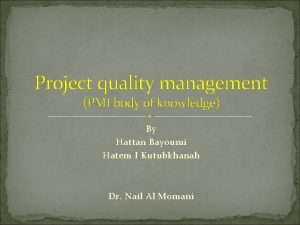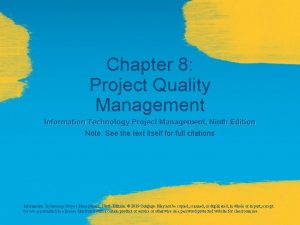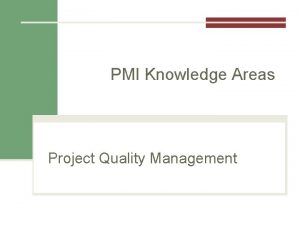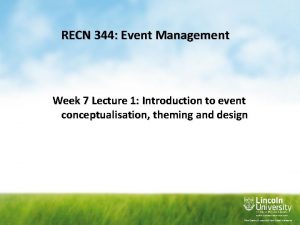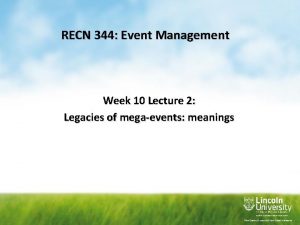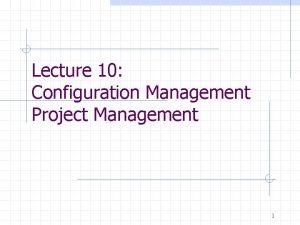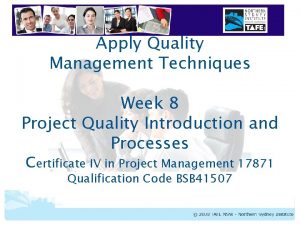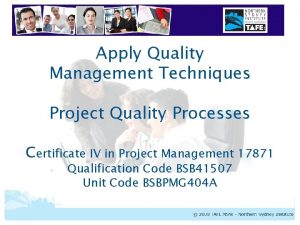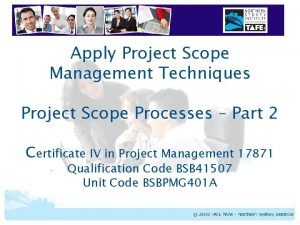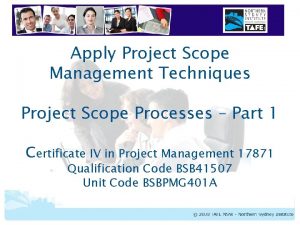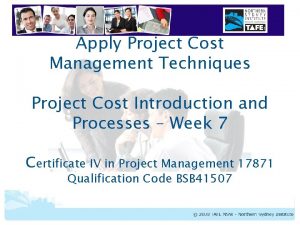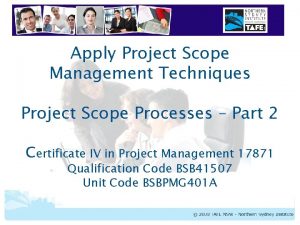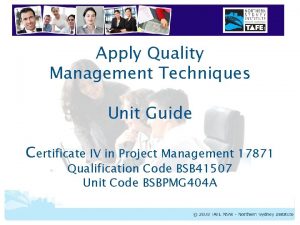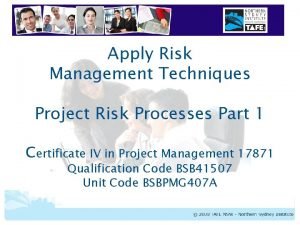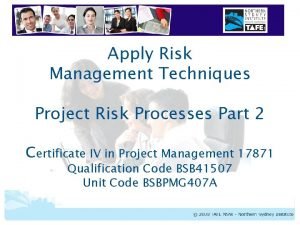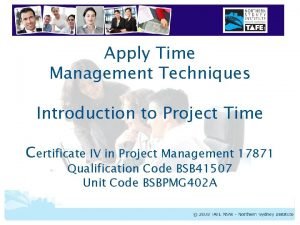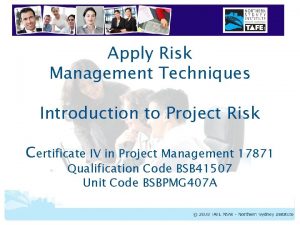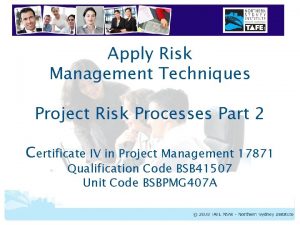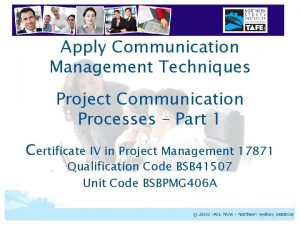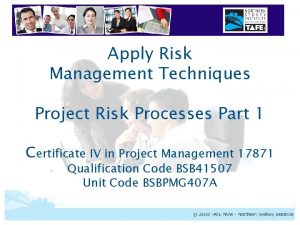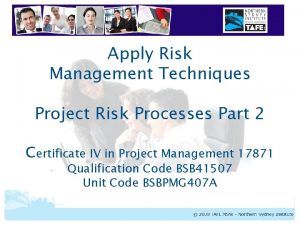Apply Quality Management Techniques Week 8 Project Quality








































- Slides: 40

Apply Quality Management Techniques Week 8 Project Quality Introduction and Processes Certificate IV in Project Management 17871 Qualification Code BSB 41507 Unit Code BSBPMG 404 A Apply Quality Management Techniques

What Is Quality? • The International Organization for Standardization (ISO) defines quality as ‘the degree to which a set of inherent characteristics fulfils requirements’ (ISO 9000: 2000). • Quality can also be based on conformance to requirements and fitness for use. • Conformance to requirements - The project’s processes and products meet written specifications. • Fitness for use - A product can be used as intended in the design BSBPMG 404 A Apply Quality Management Techniques 2

Conformance vs Fitness Example • Many people fail to understand the difference between ‘Conformance to Requirements’ and ‘Fitness for Use’, here is an example… • I need to buy a new car that can safely get me from Sydney to the Gold Coast. If this is my only requirement then I can buy any car on the market, and it would make sense to buy the cheapest possible car, as it would be meet ‘Fitness for Use’ criteria. • Why then, do I wait to buy the new Subaru Outback V 6 turbo diesel? • It is probably due to the fact that I had other non stated requirements such as wanting an All Wheel Drive; a brand preference for Subaru; and a high safety expectation. • Buying the cheapest car would have met the ‘Fitness for Use’ criteria, but buying the Subaru meets my ‘Conformance to Requirements’ criteria. BSBPMG 404 A Apply Quality Management Techniques

What Is Project Quality Management? • Project quality management ensures that the project outcomes will satisfy the needs for which the project was undertaken • It is critical to plan for quality outcomes. • Quality planning involves identifying which quality standards are relevant to the project, product and deliverables and how these will be – ü Included in the design and build processes – Quality Assurance ü Checked for conformance on completion – Quality Control BSBPMG 404 A Apply Quality Management Techniques 4

What Is Project Quality Management? • Project quality management addresses the quality requirements of the overall project and any products or deliverables are produced • The quality measures and techniques used are unique to the characteristics of the product • Project quality management is compatible with many different types of quality management approaches such as Six Sigma, Total Quality Management and ISO (International Organisation for Standardisation) BSBPMG 404 A Apply Quality Management Techniques

Basic Principles of Quality Management • Quality management complements project management, both disciplines recognise the importance of – ü Customer satisfaction ü Prevention over inspection ü Continuous improvement • Customer satisfaction – defining requirements and managing expectations so that customer requirements are met • Prevention over inspection – quality should be built in to the processes used to produce product and deliverables as the cost of preventing defects is less than the cost of fixing them at the end • Continuous improvement – learning from previous projects is built into future projects to ensure improvement, learnings can also be incorporated during project execution BSBPMG 404 A Apply Quality Management Techniques 6

Project Quality Responsibilities • Project Managers are ultimately responsible for quality management on their projects • Many large organisations have internal quality and risk management departments that should be able to assist with the identification of relevant standards and methodologies, as well as internal policies and procedures • Project Managers must seek out the quality standards relevant to – ü their industry, ü the project, and ü the product BSBPMG 404 A Apply Quality Management Techniques 7

The Importance of Quality Management • Failure to meet the quality requirements is a common reason for project failure and can have serious negative results • The quality of the end product of a project is critical, things can go drastically wrong if the end product does not meet the requirements ü People can die if machinery and medical equipment malfunctions ü People can loose their money if new banking systems don’t work correctly ü Space missions can fail if there are errors in project execution BSBPMG 404 A Apply Quality Management Techniques

Quality Management Terms for Projects Quality – ü the degree to which a set of inherent characteristics fulfill the requirements Cost of Quality – ü total cost of all efforts related to quality throughout the project or product development lifecycle Quality Audit – ü the process of examing the quality system or quality management plan, often carried out by an internal or external quality auditor or an audit team. A key element in the ISO quality system. BSBPMG 404 A Apply Quality Management Techniques

Quality Management Terms for Projects Quality Assurance – ü quality activities that are built in to the processes used to create the product and deliverables, can be performed by a manager, client, or even a third-party reviewer. E. g. reviews, process checklists and quality audits. Quality Control – ü quality activities performed at the completion of a product or deliverable, used to verify that deliverables meet the requirements and that they are complete and correct. E. g. inspection and testing. BSBPMG 404 A Apply Quality Management Techniques

Quality Assurance vs Quality Control • Quality control and quality assurance are important concepts, yet most project managers have only a vague understanding of the meanings and the differences between these terms. • Quality Assurance – ü Quality assurance activities are focused on the process used to create the deliverable. ü periodically evaluating overall project performance to ensure the project will satisfy the relevant quality standards. • Quality Control – ü Quality control activities are focused on the deliverable itself ü monitoring specific project results to ensure that they comply with the relevant quality standards BSBPMG 404 A Apply Quality Management Techniques

Quality Assurance vs Quality Control An important distinction – Quality Assurance Quality Control During Development On Completion Finding and correcting defects during quality assurance is much cheaper than finding and correcting defects during quality control BSBPMG 404 A Apply Quality Management Techniques

International Organisation for Standardisation • ISO (International Organization for Standardization) is the world's largest developer and publisher of International Standards. • ISO is a network of the national standards institutes of 161 countries, one member per country, with a Central Secretariat in Geneva, Switzerland, that coordinates the system. • ISO is a non-governmental organisation that forms a bridge between the public and private sectors. Many of its member institutes are part of the governmental structure of their countries, or are mandated by their government. Other members have their roots uniquely in the private sector, having been set up by national partnerships of industry associations. BSBPMG 404 A Apply Quality Management Techniques

ISO Quality Standards • ISO 9000 is a quality system standard that ü is a three-part, continuous cycle of planning, controlling, and documenting quality in an organization. ü provides minimum requirements needed for an organization to meet its quality certification standards. ü helps organisations around the world reduce costs and improve customer satisfaction. • The most commonly implemented family of quality standards is ISO 9001: 2008 - Quality management systems – Requirements BSBPMG 404 A Apply Quality Management Techniques 14

Standards Australia • Standards Australia is the nation’s peak non-government Standards organisation. It is charged by the Commonwealth Government to meet Australia’s need for contemporary, internationally aligned Standards and related services. • The work of Standards Australia enhances the nation’s economic efficiency, international competitiveness and contributes to community demand for a safe and sustainable environment. • It leads and promotes a respected and unbiased Standards development process ensuring all competing interests are heard, their points of view considered and consensus reached. • Standards are printed by their publishing company SAI Global, where you can purchase any ISO, AS (Australian Standard) or IEC (International Electrotechnical Commission) standards. BSBPMG 404 A Apply Quality Management Techniques

Common Quality Standards • There are many common quality standards available that cover different industries ü AS ISO 10006: 2003 – Quality management system – guidelines for quality management in projects ü BCA 2008 and BCA 2009 - Building Codes of Australia ü ISO 22000 - Food Safety ü AS/NZS 4801: 2001 - Occupational health and safety management ü ISO 14000/ 14001 - Environmental Management Standard ü ISO/IEC 15504 - Software Process Improvement and Capability d. Etermination (SPICE) ü ISO/IEC 25000: 2005 - Software product Quality Requirements and Evaluation (SQua. RE) BSBPMG 404 A Apply Quality Management Techniques 16

Different Quality Tools and Techniques • There are many different quality tools and techniques, the selection of these is determined by – ü the type of product being delivered by the project, ü organisational policies and procedures, and ü selected external standards Quality Standards Inspection Control Charts Statistical Sampling Design of Experiments Cost of Quality Pareto Chart Histograms Quality Management Methodologies Cost-Benefit Benchmarking Cause & Flowcharting Effect Diagrams Analysis BSBPMG 404 A Apply Quality Management Techniques Run Chart Failure Mode (FMEA)

Quality Management Methodologies Six Sigma – ü mathematically based process improvement approach focusing on customer satisfaction and defect reduction, used first at Motorola and used extensively at GE Corporation Total Quality Management (TQM) – ü management strategy that embeds awareness of quality in all organisational processes. TQM has been widely used in manufacturing, as well as NASA space and science programs Other Proprietary Methodologies – ü Lean Six Sigma, Quality Function Deployment, Deming, Juran, Cosby etc ü Can be selected by your organisation for quality management purposes BSBPMG 404 A Apply Quality Management Techniques

Deming’s Quality Equation Results of Work Efforts Quality = Total Costs Increased Quality Focus on Quality Decreased Costs Decreased Quality Focus on Cost Increased Costs BSBPMG 404 A Apply Quality Management Techniques

Quality Tools and Techniques Benchmarking – ü generates ideas for quality improvements by comparing specific project practices or product characteristics to those of other projects or products within or outside the performing organisation, relates to lesson learnt Cost Benefit Analysis – ü Primary benefits of meeting quality requirements are less rework, higher productivity, lower costs and increased stakeholder satisfaction. Compares the cost of the quality activity with the benefits. Flowcharting and Process Analysis– ü Graphical representation of a process that helps to identify potential quality problems. Examination of process efficiency and failures BSBPMG 404 A Apply Quality Management Techniques

Quality Tools and Techniques Cost of Quality – ü Totals all costs incurred in quality assurance and quality control activities over the life of the project, product or deliverable. Includes cost of rework and defect rectification. Cost of Conformance Prevention Costs • Training • Documented processes • Equipment • Time to do it right Appraisal Costs • Testing • Destructive testing losses • Inspections BSBPMG 404 A Apply Quality Management Techniques Cost of Non Conformance Internal Failure Costs • Rework • Scrap or waste External Failure Costs • Liabilities • Repairs under warranty • Lost business

Quality Tools and Techniques Control Charts – ü Statistical method used to determine if a project or production process is stable and has predictable performance. The upper and lower limits relate to the requirements. Statistical Sampling – ü Examines a selection or sample group of outputs, products or deliverables for conformity to the requirements and quality standards Design of Experiment ü Statistical method for identifying the factors that have the most influence over the quality of the end product, determines the accuracy of testing activities BSBPMG 404 A Apply Quality Management Techniques

Quality Tools and Techniques Inspection – ü Examination of a deliverable or product to determine if it meets the documented quality standards and requirements Cause and Effect Diagrams – ü Ishikawa or fishbone diagrams. Illustrate the linkages between quality problems and their potential causes Failure Mode Effects Analysis – ü More comprehensive that Cause and Effect Diagrams, involves determining ALL potential failures, the impacts of the failures and actions to both manage and prevent failures BSBPMG 404 A Apply Quality Management Techniques

Quality Tools and Techniques Histograms – ü Bar chart used to document the frequency with which certain events (defects or failures) occur Pareto Charts or Pareto Diagrams – ü Type of histogram that is ordered by frequency of occurrence. It shows the defects generated by the categories of the identified causes Run Chart ü Similar to a control chart but doesn’t display the upper and lower performance limits, shows total variation in a process over time to enable trend analysis BSBPMG 404 A Apply Quality Management Techniques

Meeting Quality Outcomes To meet the quality requirements, Project Managers must – ü Ensure that detailed requirements and specifications are documented and agreed with stakeholders ü Understand the relevant quality standards for their industry and product ü Understand follow organisational quality methodologies, policies and procedures ü Plan for quality assurance and quality control activities in detail ü Detail the impacts of change requests on quality requirements and processes ü Ensure that defects are repaired and monitored BSBPMG 404 A Apply Quality Management Techniques

Project Quality Management Processes PMBOK Project Quality Management Processes 8. 1 Plan Quality 8. 2 Perform Quality Assurance 8. 3 Perform Quality Control Related processes from Project Integration Management – 4. 2 Develop Project Management Plan 4. 6 Close Project PMBOK 4 th Edition BSBPMG 404 A Apply Quality Management Techniques

4. 2 Develop Project Management Plan • This is the process of defining and documenting the actions necessary to prepare and integrate all subsidiary plans for each of the 8 key knowledge areas of project management. • The planning processes for all project management key knowledge areas are normally performed at the same time and during this process, or expanded upon shortly afterwards. • It is progressively updated during project execution via the Perform Integrated Change Control process (PMBOK 4. 5) Monitor Initiation Planning Execution Close Control Adapted from PMBOK 4 th Edition BSBPMG 404 A Apply Quality Management Techniques

4. 2 Develop Project Management Plan • Typically, a stand alone plan will be developed for Quality. This is contained in the Quality Management Plan document. • It is important that Quality Assurance and Quality Control processes are defined and planned during the early stages of the Planning phase. • It can be very costly and also cause delays if these processes need to be included once the project is into Execution. • The Quality planning process (8. 1) happens concurrently with the project management planning process (4. 2) Adapted from PMBOK 4 th Edition BSBPMG 404 A Apply Quality Management Techniques

Quality Management Plan • The Quality Management Plan establishes the standards and processes to be used in Quality Assurance and Quality Control activities. • It is often overlooked on the assumption that it is too difficult to put together and that the project team will just know what is expected in terms of quality. This can result in a failure to meet project, product and deliverable quality requirements, which can leads to failure of the project or expensive rework and defect repair. • Common inclusions in the Quality Management Plan – ü Links to organisational quality management policies and procedures ü Links to specific quality standards that must be achieved ü Detailed quality requirements Monitor ü Quality Assurance process and tool definitions ü Quality Control process and tool definitions ü Defect tracking and repair processes Initiation Planning Execution Close Control Adapted from PMBOK 4 th Edition BSBPMG 404 A Apply Quality Management Techniques

8. 1 Plan Quality • The process of identifying quality requirements and standards for the project, product and deliverables. • Includes the detailed definition and documentation of the quality assurance and quality control activities, processes and tools, as well as detailed quality requirements and quality standards. • The quality planning process (8. 1) happens concurrently with the project management planning process (4. 2) • Quality is often sacrificed when pressure is applied to reduce costs or timeframes Monitor • Occurs during Planning Initiation Planning Execution Close Control Adapted from PMBOK 4 th Edition BSBPMG 404 A Apply Quality Management Techniques

8. 1 Plan Quality • Inputs to Plan Quality ü Scope Baseline - Scope Statement and WBS ü Cost baseline ü Schedule baseline ü Risk Register ü Government regulations ü Standards – internal and external ü Quality Management System ü Quality policies and procedures ü Lessons learned from previous projects • Tools and techniques included in Quality Introduction in the Learning Program. Adapted from PMBOK 4 th Edition BSBPMG 404 A Apply Quality Management Techniques

8. 1 Plan Quality • Outputs of this process include – ü Quality Management Plan – Detailed contents covered in slide 7 ü Quality Metrics – Part of detailed quality requirements ü Quality Checklists – Part of Quality Control and sign off processes ü Process Improvement Plan – advanced technique – Most relevant to projects with specific process improvement outcomes, e. g. those using Six Sigma’s project methodology Monitor ü Project Document Updates Initiation Planning – Stakeholder Register and Responsibility Assignment Matrices (part of Project Human Resources) Execution Close Control Adapted from PMBOK 4 th Edition BSBPMG 404 A Apply Quality Management Techniques

Quality Assurance vs Quality Control • Quality control and quality assurance are important concepts, yet most project managers have only a vague understanding of the meanings and the differences between these terms. • Quality Assurance – ü Quality assurance activities are focused on the process used to create the deliverable. ü periodically evaluating overall project performance to ensure the project will satisfy the relevant quality standards. • Quality Control – ü Quality control activities are focused on the deliverable itself ü monitoring specific project results to ensure that they comply with the relevant quality standards BSBPMG 404 A Apply Quality Management Techniques

8. 2 Perform Quality Assurance • The process of executing the quality assurance processes that have been designed during planning. • Quality processes that are applied during the development of products and deliverables. • Always the responsibility of the Project Manager, but often there are internal quality assurance departments that will offer assistance in standards and execution. • Associated with continuous process improvement • Occurs during Execution Monitor Initiation Planning Execution Close Control Adapted from PMBOK 4 th Edition BSBPMG 404 A Apply Quality Management Techniques

8. 2 Perform Quality Assurance • Inputs to Perform Quality Assurance ü Quality Management Plan ü Process Improvement Plan – advanced technique ü Quality Metrics ü Work Performance Information ü Status Information ü Quality Control Measurements • Tools and techniques included in Quality Introduction in the Learning Program. Monitor Initiation Planning Execution Close Control Adapted from PMBOK 4 th Edition BSBPMG 404 A Apply Quality Management Techniques

8. 2 Perform Quality Assurance • Outputs of this process include – ü Updates to Quality Standards ü Change Requests ü Defect Reports and Defect Register ü Updates to Quality Management Plan ü Updates to Schedule Management Plan ü Updates to Cost Management Plan ü Quality Audit and Status Reports Monitor ü Updates to Training Plans Initiation ü Updates to Process Documentation Planning Execution Close Control Adapted from PMBOK 4 th Edition BSBPMG 404 A Apply Quality Management Techniques

8. 3 Perform Quality Control • The process of executing the quality control processes that have been designed during planning. • Quality monitoring and sign off processes that are applied on completion of deliverables and products during execution of the project. • Quality monitoring and sign off processes that are applied upon completion of the entire project to determine overall success against both performance measures and quality requirements. • Always the responsibility of the Project Manager, but often there are internal quality control departments that will offer assistance, e. g. many IT departments have separate software testing teams. • Associated with continuous process improvement • Occurs during Monitoring and Control Monitor Initiation Planning Execution Close Control Adapted from PMBOK 4 th Edition BSBPMG 404 A Apply Quality Management Techniques

8. 3 Perform Quality Control • Inputs to Perform Quality Control ü Quality Management Plan ü Quality Metrics ü Quality Checklists ü Work Performance Information ü Status Information ü Approved Change Requests ü Products and Deliverables for review and testing ü Quality standards and policies ü Defect reporting procedures • Tools and techniques included in Quality Introduction in the Learning Program. Adapted from PMBOK 4 th Edition BSBPMG 404 A Apply Quality Management Techniques

8. 3 Perform Quality Control • Outputs of this process include – ü Quality Control Measurements ü New Change Requests ü Validated Defect Repairs ü Validated and signed off Products and Deliverables ü Completed Checklists ü Lessons Learned ü Updates to Quality Management Plan Monitor ü Updates to Process Improvement Management Plan ü Updates to Quality Standards Initiation Planning Execution Close Control Adapted from PMBOK 4 th Edition BSBPMG 404 A Apply Quality Management Techniques

Team Assignment Criteria Team Assignment Components Marks Basic Competency Higher Competency Quality Requirements 7 Quality requirements defined for all major deliverables List of all standards, regulations, methodologies, policies and procedures that must be followed Quality requirements also specified for project management deliverables Cost of quality assurance and management activities defined Quality Management Processes 6 Detailed processes for the assurance and rectification of quality issues, including review, sign off and acceptance responsibility Processes provided for the implementation of improvements Quality management tools and techniques used to ensure the quality requirements are met 7 Basic understanding of tools and techniques At least two different quality assurance methods used Advanced understanding of tools and techniques More than two methods used and experts consulted 20 13 to 16 17 to 20 Total BSBPMG 404 A Apply Quality Management Techniques
 Cross apply vs outer apply
Cross apply vs outer apply Qcc tools and techniques
Qcc tools and techniques Week by week plans for documenting children's development
Week by week plans for documenting children's development Introduction to software project management
Introduction to software project management Quality management techniques
Quality management techniques Total quality management tools and techniques
Total quality management tools and techniques Tqm techniques
Tqm techniques Quality management tools
Quality management tools Risk mitigation techniques in project management
Risk mitigation techniques in project management Project management techniques pert and cpm
Project management techniques pert and cpm Project management facilitation techniques
Project management facilitation techniques What is network technique
What is network technique What are quality standards in project management
What are quality standards in project management Project quality management definition
Project quality management definition What are quality standards in project management
What are quality standards in project management Project quality management lecture notes
Project quality management lecture notes Quality management pmbok
Quality management pmbok Control chart precision accuracy pmp
Control chart precision accuracy pmp Project quality management pmp
Project quality management pmp Information technology project management 8th edition
Information technology project management 8th edition Project management quality control
Project management quality control Importance of project quality management
Importance of project quality management Project 6 week 5
Project 6 week 5 The role of project management in achieving project success
The role of project management in achieving project success Modern project profiles in spm
Modern project profiles in spm Project cost duration graph
Project cost duration graph Introduction to project management kathy schwalbe
Introduction to project management kathy schwalbe Project evaluation in software project management
Project evaluation in software project management Perpetual project closure
Perpetual project closure Agile ms project template
Agile ms project template Types of project termination
Types of project termination Les fonctions techniques et les solutions techniques
Les fonctions techniques et les solutions techniques Operations and quality management
Operations and quality management Supply chain management and total quality management ppt
Supply chain management and total quality management ppt What is tqm
What is tqm Management week event
Management week event Management week event
Management week event Asset management vs project management
Asset management vs project management Configuration management system pmp
Configuration management system pmp Basic principles of cost management in project management
Basic principles of cost management in project management Software
Software
